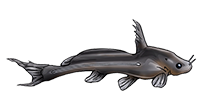/siluriformes/loricariidae/otocinclus/vittatus/1.jpg)
LDA023, Common Otocinclus, Dwarf Sucker, Ohrgitterharnischwels (Germany), Oto, Stribet Dværgsugemalle (Denmark) - Otocinclus vittatus Regan, 1904
Article © Julian Dignall, uploaded December 01, 1996.
This fish is too often overlooked. I must admit to being one of these "overlookers" for some time. The Dwarf Sucker or "Oto" isn't a spectacular looking fish, but if kept correctly, more than makes up for this cosmetic shortcoming in an abundance of character.
My involvement in keeping Otocinclus at home in the last few years began when I saw a large tank full of these fish. They were very active, swimming around and generally having a ball. Previously I had only seen for sale two or three docile individuals in a single tank. Like Clown Loaches (Chromobotia macracanthus), these fish really come into their own when settled and kept in numbers. Unlike the loaches they don't possess an eye-catching colouration and this can lead to them being sadly over looked by the aquatic shopper.
I started with half a dozen of these fish which, admittedly, was decreased by the loss of three in fairly short order. Not to be discouraged this was increased to a group of 10 fish. Removing the Sailfin Pleco (Pterygoplichthys gibbiceps) that was "blamed" for depriving the smaller Loricariids of their food also helped. The group flourished and kept the local flora (A clump of Amazon Sword Plants) free of unsightly hair and brown algae. The fish quite often swam in trios or more in mid-water (Corydoras style). They excel at algae housekeeping and as such are heartily recommended by Takashi Amano in his visually stunning "Nature Aquarium World".
There are other species of Otocinclus and the similar Parotocinclus available from time to time; these are very similar in terms of care and maintenance. A few words of warning about Otocinclus, make sure you filter intake pipes are not capable of sucking the Dwarf Sucker! Furthermore although I do not think they were being aggressive, but I had to remove Otocinclus from a Discus (Symphosodon sp.) tank because they were attaching themselves on the Cichlids. This behaviour may also be a problem to Angelfish (Pterophyllum sp.), or other slow-moving high-bodied fish.
Copyright information for the images used in this article can be found on the species' full Cat-eLog page.
| Scientific Name | Otocinclus vittatus Regan, 1904 |
| Common Names | LDA023, Common Otocinclus Dwarf Sucker, Ohrgitterharnischwels (Germany), Oto, Stribet Dværgsugemalle (Denmark) |
| Type Locality | Descalvados, Rio Paraguay system, Mato Grosso State, Brazil. |
| Synonym(s) | Rhamdella paraguensis, Rhinolepis paraguensis |
| Pronunciation | auto SINK luss - vit TAT us |
| Etymology | Greek, ous, oto = ear + Latin, cinclus = latticework; in allusion to the holes of the head in the ears. |
| Articles | |
| Size | 33mm or 1.3" SL. Find near, nearer or same sized spp. |
| Identification | Very similar indeed to O. mariae. |
| Sexing | Females are larger and broader especially when viewed from above. |
| Distribution | South America: Amazon, Orinoco, Paraná/Paraguay, Xingu and Tocantins River basins. Amazon (click on these areas to find other species found there) La Plata, Paraná (click on these areas to find other species found there) La Plata, Paraná, Paraguay (click on these areas to find other species found there) Orinoco (click on these areas to find other species found there) Amazon, Lower Amazon, Xingu (click on these areas to find other species found there) Amazon, Lower Amazon, Tocantins (click on these areas to find other species found there) La Plata, Paraná, Paraguay, Upper Paraguay (click on these areas to find other species found there) Login to view the map. |
| IUCN Red List Category | Least Concern , range map and more is available on the IUCN species page. Last assessed 2020. |
| pH | 5.5 - 7.5 |
| Temperature | 21.0-26.0°C or 69.8-78.8°F (Show species within this range) |
| Feeding | Initially algae, add a shoal to an ''algaefied'' tank and then supplement diet with sinking tablets and the usual cucumbers / lettuce or courgette (zucchini). User data. |
| Furniture | Large leafed plants and vertical flat rock surfaces (especially slate). Not essential, but likes bogwood and a large rounded substrate. Live plants seem essential to the long term survival of this fish. |
| Compatibility | Peaceful. |
| Suggested Tankmates | Keep in groups (preferably at least six) with any small to mid-sized community fish. |
| Breeding | See Shane's World Article |
| Breeding Reports | There are 4 breeding reports, read them all here. |
| Reference | Transactions of the Zoological Society of London v. 17 (pt 3, no. 1), pp 267, Pl. 15 (fig. 3). |
| Registered Keepers | There are 271 registered keepers, view all "my cats" data. |
| Wishlists | Love this species? Click the heart to add it to your wish list. There are 7 wishes to keep this species, see who wants what. |
| Spotters | Spotted this species somewhere? Click the binoculars! There are 67 records of this fish being seen, view them all. |
| Forum BBCode | |
| Search for O. vittatus | |
| Look up O. vittatus on AquaticRepublic.com | |
 | Look up O. vittatus on Fishbase |
 | Look up O. vittatus on Encyclopedia of Life |
 | Look up O. vittatus on Global Biodiversity Information Facility |
| LFS label creator ARN ref:1.4.49.107 | |
| Last Update | 2020 Oct 23 04:08 (species record created: 1996 Dec 01 11:22) |
Back to Catfish of the Month index.




